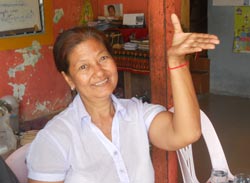 The Dance Teacher's Story The Dance Teacher's Story
In travel, sometimes a detour -- whether literal or metaphorical -- can end up being an unexpected highlight you remember forever. That's what happened during my recent trip to Cambodia, ELI's newest volunteer and internship destination.
I was at an orphanage in Phnom Penh where children age 8-15, in addition to going to school, study classical Cambodian (or, Khmer) dance which they also perform at the city's weekend night market.
The orphanage is a very modest place -- a few dusky, crowded rooms for sleeping, a couple of open-air rooms to relax and practice in, all under a corrugated metal roof that makes the building feel more like a large shack than a home for 20-some children.
Peng Phan is the orphanage's dancing teacher and primary care giver. She's a petite woman in her 60's with a gentle manner and a soft smile. She's clearly the heart and soul of this orphanage.
It's only during our conversation that I discover this gracious woman's horrible war-time past. She tells it quietly, but with growing emotion.
Phan is a survivor of the genocide committed by the Communist forces of the Khmer Rouge between 1975 and 1979, when an estimated 2-million people were murdered, many of them members of Cambodia's educated class: teachers, scientists, artists, and dancers like her.
When the Khmer Rouge took over, Phan was a TV news broadcaster who as a child and young woman had studied classical Khmer dance. She was a public figure. She was educated. She was in danger.
Phan fled the city, heading northwest to Batambang, not far from the Thai border, but by 1976 she'd been found and arrested. Along with an estimated 500 people, including many children, she was held at a Buddhist temple converted into a prison camp. During the day, they toiled in the fields, working under the watchful eyes of armed Khmer Rouge guards. They dug irrigation ditches 16 hours per day, with little water or food. Those who fell ill and couldn't work for more than 3 days were beaten to death. There was widespread disease and hunger. Phan recalls teaching the imprisoned children to look for snails and crabs, which they would eat raw. Anything for protein. Anything to survive.
She lived like this until Vietnamese forces defeated the Khmer Rouge in 1979 and liberated the camp. Of the 500 people imprisoned with her three years earlier, only 15 survived.
The seriousness with which Phan takes her orphanage job as a teacher and surrogate mother is a result of what she experienced. She saw many children die during the war, so she gives her all to make sure "her" orphaned youngsters live with love and care. Her art -- the glorious Khmer classical dance -- was nearly wiped out (more than 90% of dancers and dance instructors were murdered by the Khmer Rouge) so she gives it new life by teaching it to a new generation. They are the torch bearers.
It's been days since I've left Peng Phan and her small orphanage on a Phnom Penh side street. But they remain indelible in my mind. I met a witness to history, a survivor of horror. I feel privileged to work on her behalf.
To read more about the Khmer Rouge and its crimes against the Cambodian people, check out this Washington Post report or this New York Times article about recent war criminal trials of Khmer Rouge leaders.
If you'd like to help out at this orphanage or one of our other Cambodia projects, see our Cambodia page.
By Kevin O'Neill
|